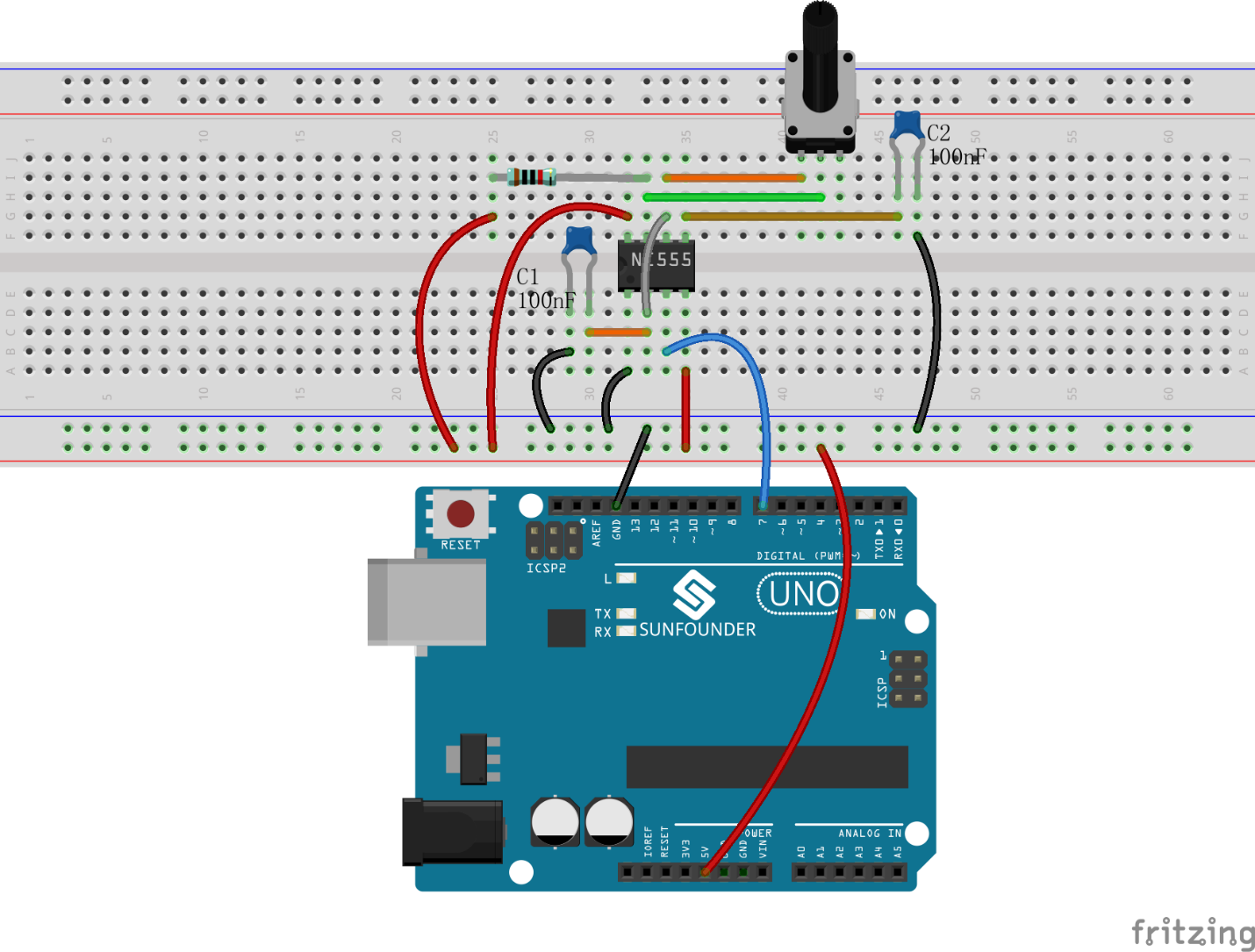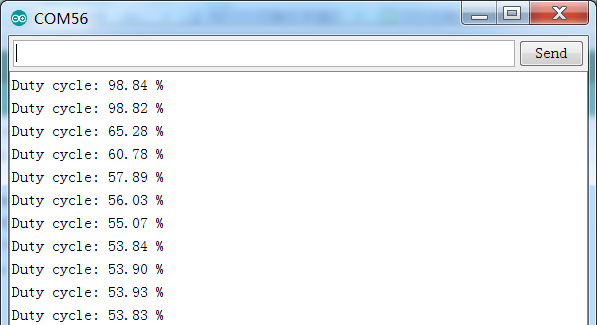Introduction
The NE555 Timer, a mixed circuit composed of analog and digital circuits, integrates analog and logical functions into an independent IC, thus tremendously expanding the applications of analog integrated circuits. It is widely used in various timers, pulse generators, and oscillators. In this experiment, the SunFounder Uno board is used to test the frequencies of square waves generated by the 555 oscillating circuit and show them on Serial Monitor.
Components
– 1 * SunFounder Uno board
– 1 * USB cable
– 1 * Breadboard
– 1 * NE555
– 2 * 104 ceramic capacitor
– 1 * Potentiometer (50KΩ)
– 1 * Resistor (10KΩ)
– Jumper wires
Principle
555 IC
The 555 IC was originally used as a timer, hence the name 555 time base circuit. It is now widely used in various electronic products because of its reliability, convenience, and low price. The 555 is a complex hybrid circuit with dozens of components such as a divider, comparator, basic R-S trigger, discharge tube, and buffer.
Its pins and their functions:

As shown in the picture, the pins are set dual in-line with the 8-pin package.
- Pin 1 (GND): the ground
- Pin 2 (TRIGGER ): when the voltage at the pin reduces to 1/3 of the VCC (or the threshold defined by the control board), the output terminal sends out a High level
Pin 3 (OUTPUT): outputs High or Low, two states 0 and 1 decided by the input electrical level; maximum output current approx. 200mA at High
- Pin 4 (RESET): when a Low level is received at the pin, the timer will be reset and the output will return to Low level; usually connected to positive pole or neglected
- Pin 5 (CONTROL VOLTAGE): to control the threshold voltage of the chip (if it skips connection, by default, the threshold voltage is 1/3 VCC and 2/3 VCC)
- Pin 6 (THRESHOLD): when the voltage at the pin increases to 2/3 VCC (or the threshold defined by the control board), the output terminal sends out a High level
- Pin 7 (DISCHARGE): output synchronized with Pin 3, with the same logical level; but this pin does not output current, so pin 3 is the real High (or Low) when pin 7 is the virtual High (or Low); connected to the open collector (OC) inside to discharge the capacitor
- Pin 8 (VCC): positive terminal for the NE555 timer IC, ranging +4.5V to +16V
- The NE555 timer works under the monostable, astable and bistable modes. In this experiment, apply it under the astable mode, which means it works as an oscillator, as shown below

Connect a resistor R1 between the VCC and the discharging pin DS, another resistor between pin DS and the trigger pin TR which is connected to the threshold pin TH and then to the capacitor C1. Connect the RET (pin 4) to GND, CV (pin 5)to another capacitor C2 and then to the ground.
Working process:
The oscillator starts to shake once the circuit is power on. Upon the energizing, since the voltage at C1 cannot change abruptly, which means pin 2 is Low level initially, set the timer to 1, so pin 3 is High level. The capacitor C1 charges via R1 and R2, in a time span:
Tc=0.693(R1+R2)
When the voltage at C1 reaches the threshold 2/3Vcc, the timer is reset and pin 3 is Low level. Then C1 discharges via R2 till 2/3Vcc, in a time span:
Td=0.693(R2)
Then the capacitor is recharged and the output voltage flips again:
Duty cycle D=Tc/(Tc+Td)
Since a potentiometer is used for resistor, we can output square wave signals with different duty cycles by adjusting its resistance. But R1 is a 10K resistor and R2 is 0k-50k, so the range of the ideal duty cycle is 0.545%-100%. If you want another else, you need to change the resistance of R1 and R2.
Dmin=(0.693(10K+0K))/(0.693(10K+0K)+0.693x0k) x100%=100%
Dmax=(0.693(10K+50K))/(0.693(10K+50K)+0.693x50k) x100%=54.54%
Experimental Procedures
Step 1:Build the circuit (pay attention to the direction of the chip by the concave on it)

Step 2: Open the code file
Step 3: Select correct Board and Port
Step 4: Upload the sketch to the SunFounder Uno board
After uploading, the duty cycle will be displayed in Serial Monitor.:




Code
| //NE555 Timer //After burning the program, open the serial monitor,you can see that if you rotate the potentiometer, the length of the pulse (in microsecond) displayed will change accordingly. //Email:support@sunfounder.com //Website:www.sunfounder.com //2015.5.7 int ne555 = 7; //attach to the third pin of NE555 unsigned long duration1; //the variable to store the HIGH length of the pulse unsigned long duration2; //the variable to store the LOW length of the pulse float dc; //the variable to store the duty cycle void setup() { pinMode(ne555, INPUT); //set the ne555 as an input Serial.begin(9600); // start serial port at 9600 bps: } void loop() { duration1 = pulseIn(ne555, HIGH); //Reads a pulse on ne555 duration2 = pulseIn(ne555, LOW); //Reads a pulse on ne555 dc = float (duration1) / (duration1 + duration2) * 100; Serial.print(“Duty cycle: “); Serial.print(dc); //print the length of the pulse on the serial monitor Serial.print(” %”); Serial.println(); //print an blank on serial monitor delay(500); //wait for 500 microseconds } |
